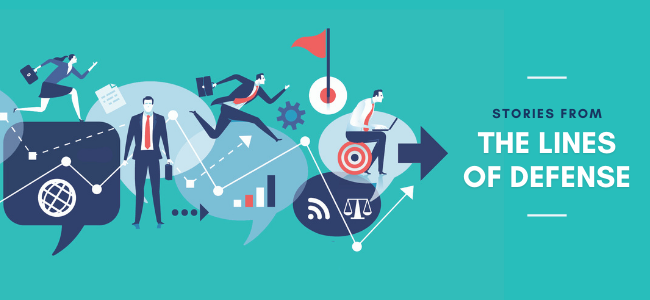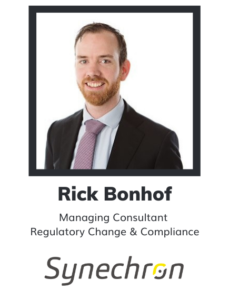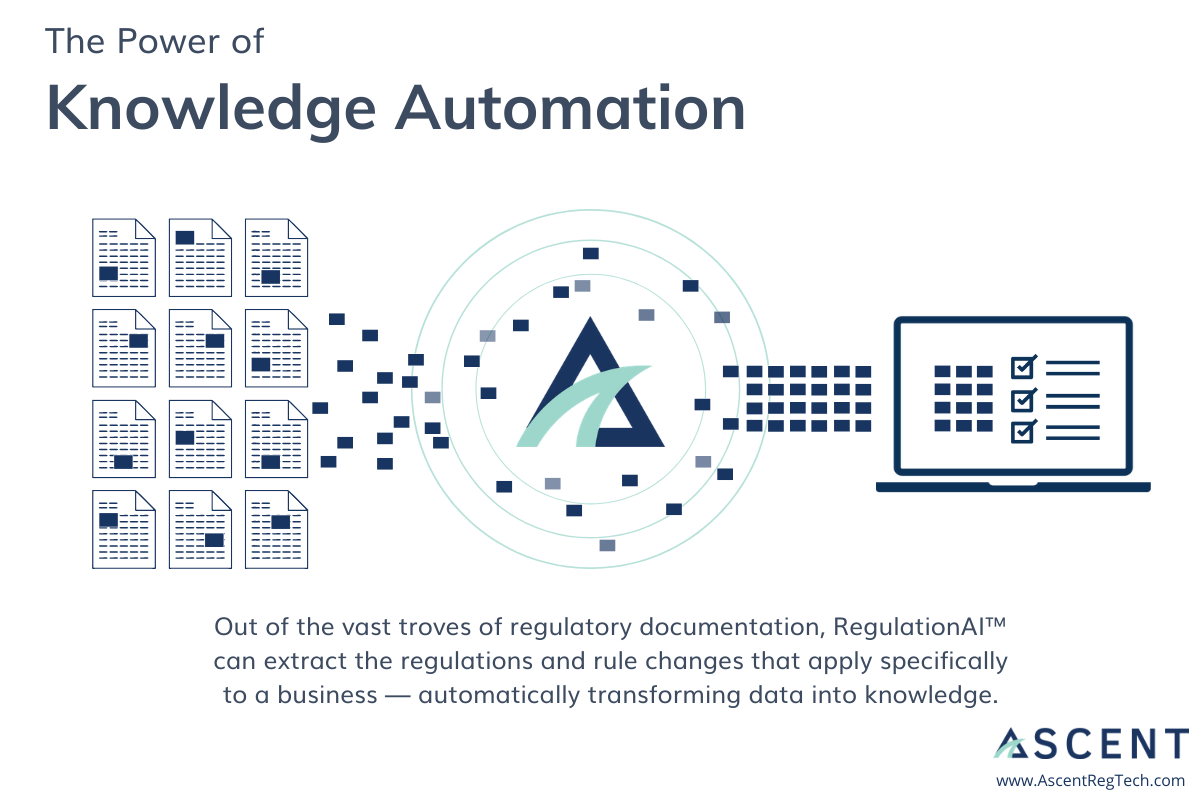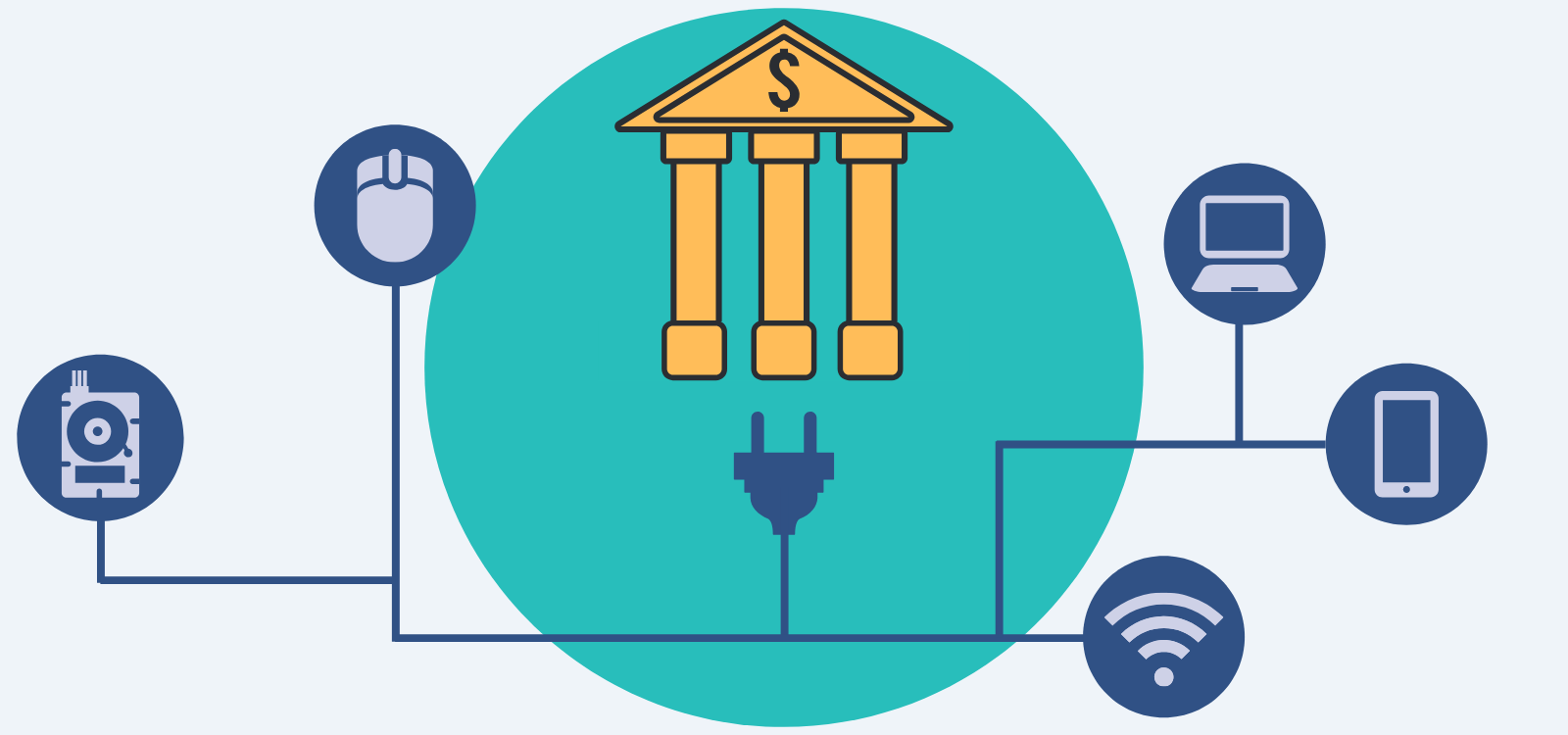
As a young industry, RegTech often gives rise to a host of questions — everything from “what is it?” to “how does it work?” to “how will it affect me?” We’ve collected a handful of the more common ones and answered them below.
Have a question that’s not on our list? Drop us a line at marketing@ascentregtech.com and we will be happy to help answer it!
What does RegTech mean?
RegTech (Regulatory Technology) is the application of emerging technology to improve the way businesses manage regulatory compliance.
RegTech companies can be established GRC (Governance, Risk, and Compliance) platforms, startup companies, and everything in between. They are united by their use of new, groundbreaking technology in the service of solving the problems of regulatory compliance.
As an industry, RegTech has emerged over the last few years to address the rising tide of regulation and its growing complexity. To learn more about the history and future of RegTech, check out our comprehensive guide, “What is RegTech?”
READ MORE: What is RegTech?
What are the benefits of RegTech?
For financial services, the benefits of RegTech are substantial:
- Efficiency gains — As regulation continues to grow, it becomes nearly impossible for compliance personnel to keep up without the aid of technology. Technology, capable of processing a high volume of data at incredible speeds, can quickly parse and analyze raw legal text and extract valuable insights.
- Greater accuracy and comprehensiveness — Manual, siloed processes tend to create gaps in the compliance operation, leading to human error and increased exposure. Implementing the right technology (and integrating those technologies thoughtfully where necessary) shores up gaps and creates a streamlined compliance process.
- Greater internal alignment — Technology tools enable greater transparency throughout the business, connecting once siloed people and processes. The result is better insights between business units that can be shared faster, which also leads to a stronger culture of compliance.
- Improved risk management — Many RegTech tools help protect against various types of risk, including market abuse, cyber attacks, and fraud, by monitoring systems and alerting personnel to suspicious activity.
READ MORE: How Ascent customers reduce risk, slash costs, and save time
What is end-to-end compliance and how does RegTech fit in?
End-to-end (E2E) compliance is a fully traceable process that connects external regulatory events to a business’ specific obligations, then all the way through to that business’ internal controls, policies, and procedures. In an ideal world, E2E compliance leverages automation and other technologies to create a complete functional system of compliance. To achieve E2E compliance, different RegTech solutions can be used together (often referred to as a ‘compliance technology stack’) to create a seamless process that automates rote work, connects once-disjointed processes, and supports a robust compliance framework.
With a properly implemented E2E system, businesses could 1) be alerted to relevant new rules or changes to existing rules, 2) be directed to the exact parts of their internal controls or P&Ps that are impacted so team members can make the appropriate changes, 3) manage their obligations digitally including assigning work and tracking progress against deadlines, 4) easily produce records of their compliance activities, and 5) generate useful reporting dashboards.
Again, due to the complexity and nuance of regulatory compliance, one-size-fits-all solution. Rather, compliance leaders should take a modular approach to building a technology stack that meets the firm’s unique circumstances and objectives.
What kind of tech stack should I consider for my compliance framework?
Compliance and Risk professionals are responsible for not only determining what their firms’ regulatory framework is, but also how to maintain it once it’s set. Thankfully, there are a number of solutions within the RegTech universe that support this effort and can be combined into a comprehensive, end-to-end tech stack. The key is to know which ones to bring into your tech stack in the first place, so here are a few types of solutions to consider:.
Regulatory content tools are situated at the beginning of the compliance process. They typically take the form of a content library, feed, or resource center. Content tools consolidate documents published by regulators into one platform (including the laws, enforcement actions, guidance, rule updates, and more), making research and horizon scanning more efficient. Leaders in this space include Thomson Reuters Regulatory Intelligence, LexisNexis and Reg-Room.
Regulatory knowledge automation is technology that bridges the gap between the raw data of regulatory content and actionable insight. Market leader Ascent, for example, generates the regulatory obligations that pertain to your specific firm based on key factors like what type of financial entity you are, what services/products you offer, and where you operate. Ascent then automatically updates your obligations as rules change. This targeted regulatory knowledge allows compliance personnel to know exactly what the firm must comply with at all times, without the manual effort.
GRC (governance, risk and compliance) platforms help operationalize compliance and often house all of a firm’s regulatory information, including obligations, controls, policies and procedures. Workflow capabilities allow users to track and manage their compliance efforts. Leaders in the space include LogicGate, MetricStream, IBM OpenPages, and RSA Archer to name a few.
Point solutions cover a wide swath of RegTechs, helping firms execute compliance in a compliant way or assess compliance with an obligation or control. These could include (but are not limited to) trade monitoring, portfolio risk, know-your-customer, anti-money laundering, operations risk management, and cybersecurity tools. Point solutions are more limited in scope than regulatory knowledge automation or GRC solutions, but when they meet the right need they can provide substantial value.
READ MORE: The first (and most difficult) step in setting a regulatory compliance framework
What technologies do RegTech solutions use?
RegTech providers leverage a wide variety of emerging technologies. Here are a few of the most common:
- Machine learning (ML) is the application of algorithms that improve automatically through experience. Rather than being specifically programmed to complete a task, ML models are fed large amounts of data, which they use to learn and improve on their own. In regulatory compliance, ML models can process large amounts of regulatory data and gradually draw conclusions about that data, becoming more and more accurate over time.
- Natural language processing (NLP) is the field of using computers to process and analyze human language. In compliance, NLP can parse the unstructured raw text of regulation and reorganize it or otherwise transform it so that people can retrieve meaningful insights.
- Blockchain is a digital record of transactions, most often associated with cryptocurrencies. Blockchain has many other purposes however, such as enabling the secure sharing of know-your-customer data within or between organizations for compliance purposes.
- Robotic process automation (RPA) allows users to configure metaphorical “robots” or “digital workers” to replicate the actions of a human in a digital environment in order to complete a business process. RPA tools can automate laborious manual processes, like the production of hundreds of disclosures that asset management firms are required to generate throughout the year.
READ MORE: RegulationAI™: World-Class Technology Built for Compliance
What’s the difference between RegTech, FinTech, and SupTech?
RegTech leverages emerging technology to create tools focused on solving the challenges of regulatory compliance. While the majority of existing RegTech solutions are currently focused on the world of financial regulation, RegTech could also be leveraged for other regulated industries — for example, healthcare.
FinTech, short for financial technology, is the application of technology to solve problems or create new value in financial services. Examples include crowdsourcing platforms, mobile payments, cryptocurrency, robo-advisors, budgeting apps, or the use of open banking APIs. Recently, digital banks that operate purely online with no physical locations are also being referred to as FinTechs.
SupTech, short for supervisory technology, is the application of emerging technology to improve how regulators conduct supervision. Just as RegTech leverages technology for regulated companies, SupTech leverages technology for the regulators.
READ MORE: What is SupTech and how will it change compliance?
Can RegTech help me with specific regulation like GDPR?
The rise of data privacy legislation like GDPR (General Data Protection Regulation) and CCPA (California Consumer Privacy Act) have added necessary protections for consumers but have increased financial institutions’ already significant regulatory burden in the process. Depending on what you are trying to achieve with specific regulation like GDPR, RegTech offers various solutions.
There are many point solutions that help firms execute GDPR-compliant behavior. For example, UserCentrics helps firms obtain customer data in a transparent way. Syrenis provides one central platform to manage personal data, legal basis for obtaining that data, consent, and marketing practices. GDPR365 is a compliance assessor that offers guidance on what security weaknesses need to be fixed.
To understand what your organization’s obligations are under GDPR (or any other regulation), look to regulatory knowledge tools like Ascent. Ascent’s AI-driven technology pinpoints the GDPR obligations that your firm must comply with, then updates them automatically if the rules change.
READ MORE: How a Global Top 50 Bank Secured Its GDPR Obligations Using Ascent
How can I use RegTech to help my firm ease compliance burdens?
There are many use cases for RegTech, but here are some of the most common:
- Horizon Scanning — monitoring regulatory developments including rule updates, guidance, and any other communications from regulators to better understand potential threats and opportunities.
- Identifying Obligations and Changes — conducting regulatory analysis (also referred to as regulatory mapping) to understand which obligations or requirements your business must comply with. These obligations must then be routinely updated as rules change.
- Compliance Management — managing your daily compliance activities and aligning them with the broader framework of regulatory strategy and process.
Finding a solution for these use cases can be challenging since the RegTech space is vast and each solution facilitates a different part of the compliance process. Breaking the RegTech landscape into these four categories makes it easier: 1) Regulatory content tools, 2) Regulatory knowledge automation, 3) GRC platforms, and 4) Point solutions.
For the examples above, the solutions for each use case vary:
- Solution for Horizon Scanning: A regulatory content provider such as Thomson Reuters Regulatory Intelligence helps save time with horizon scanning and research.
- Solution for Regulatory Obligations: A regulatory knowledge provider such as Ascent identifies your obligations and keeps them updated as rules change. This targeted regulatory knowledge can also be used to understand downstream impact. For example, a rule change identified by Ascent can be used to trigger alerts or workflows related to that rule in your GRC or other compliance management platform.
- Solution for Compliance Management: A GRC or other compliance management system such as LogicGate or IBM OpenPages allows you to house and project manage your compliance activities, including assigning tasks, tracking progress against deadlines, and managing any internal documentation such as your controls, policies and procedures. Ascent’s granular obligations can be seamlessly fed into these systems so your regulatory data and activities are monitored, tracked, and managed all in one place.
If you are looking to accomplish all of these use cases, it is likely that your compliance operation requires multiple solutions, combined to create a full-scale compliance technology stack.
What questions should I ask a RegTech vendor that leverages “AI”?
What kinds of AI technologies do you use, and why?
First, brush up on machine learning and natural language processing basics so you can follow the vendor’s response. You do not need to be an AI expert; a good vendor will be able to explain their process in a way that any business leader can understand. What’s important is that you get a clear picture of how the specific technologies and approaches used create business value for you. Is the vendor using “AI” as a flashy marketing term, or is it actually integral to the solution?
Where are you getting the data that is training your algorithms?
Good AI tools require significant amounts of quality data – as they say, ‘bad in equals bad out.’ The vendor should be able to explain how they are ingesting regulatory text (did they build an ingestion or scraping tool, or are they white-labeing another product?), from where (the best case scenario is that the vendor is pulling straight from official regulatory websites), and at what frequency (this should be reasonably frequent so you know you have the most up-to-date information at any given time). The vendor should also be able to explain the quality-assurance process that ensures all intended data points are properly captured.
Are there humans involved in the training of your algorithms, and to what degree?
In many industries, the notion of humans-in-the-loop (meaning the technology is not 100% machine-driven; humans are still involved in some part of the process) is considered a negative sign because it means “that the tool isn’t really AI.” The compliance industry, however, is unusual in that a humans-in-the-loop process is considered a positive. Why? Because the world of regulatory compliance is so nuanced and complex, that AI solutions are far better when trained and QA-ed by human experts in regulation and law. This does not mean that all AI-driven RegTechs require humans-in-the-loop to be great tools, but the vendor should be able to explain why they do or do not involve people in the process.
Who is held liable if your solution fails?
This question is as important for you as it is for the vendor. Because this issue exists in a legal gray area, you must carefully weigh the risk of implementing any new solution (AI or not). A good AI vendor will understand why this is a concern, and should show evidence of a strong model risk management framework, rigorous internal controls, and most importantly be completely transparent about what the solution can and cannot do. If it sounds too good to be true, it probably is.
*Ascent offers a performance guarantee for its AI solution that is backed by an insurance cover from Munich Re Group. Read the case study to learn more.
—
We recommend checking out these articles to continue learning about RegTech and how it can be applied throughout the compliance process:
- The first (and most difficult step) in setting a regulatory compliance framework
- Regulatory mapping is key to compliance. Are you doing it effectively?
- Regulatory Change Management: A Tech-Based Approach
Want to receive more articles like these? Subscribe to receive helpful content designed to help you win at compliance.




 We recently sat down with Rick Bonhof, a managing consultant who leads the Amsterdam regulatory change and compliance practice within the business consulting arm of
We recently sat down with Rick Bonhof, a managing consultant who leads the Amsterdam regulatory change and compliance practice within the business consulting arm of 









